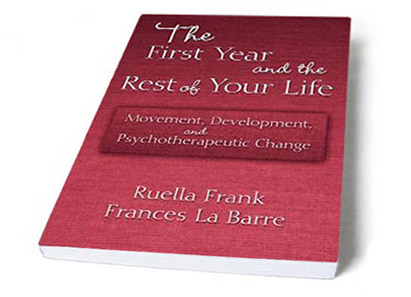The First Year and the Rest of Your Life
Movement, Development, and Therapeutic Change
Frank, R. and La Barre, F. (2010), New York, NY: Routledge Press
The movement repertoire that develops in the first year of life is a language in itself and conveys desires, intentions and emotions. This early life in motion serves as the root of ongoing nonverbal interaction and later verbal expression – in short, this language remains a key element in communication throughout life.
In their path-breaking book, gestalt therapist Ruella Frank and psychoanalyst Frances La Barre give readers the tools to see and understand the logic of this nonverbal realm. They demonstrate how observations of fundamental movement interactions between babies and parents cue us to co-constructed experiences that underlie psychological development. Numerous clinical vignettes and detailed case studies show how movement observation opens the door to understanding problems that develop in infancy and also those that appear in the continuing nonverbal dimension of adult communication.
Their user-friendly non-verbal lexicon — foundational movement analysis — enhances perception of emerging interactive patterns of parents and their babies, couples, and individual adults within psychotherapy. Clinicians in any setting will find this book to be a masterful application of infant research and movement theory that significantly augments clinical acumen and promotes greater understanding of the nonverbal basis of all relationships.
“Frank and La Barre have drawn upon years of expertise in recognizing the communicative importance of nonverbal behavior. Expanding upon the well-grounded movement perspectives of Laban, Kestenberg, Bainbridge-Cohen, and others, they extend their insights into the realm of parent-infant interaction, and awaken us to critical implications for us as psychotherapists. There are riches here pertaining to parent-infant relationships and to what makes the therapist-patient relationship effective. The bridge between these realms is exquisitely detailed in carefully observed movement interaction.”
— K. Mark Sossin, Ph.D., Professor of Psychology, Pace University, and co-author, The Meaning of Movement (1999)
“Finally, here is a work that definitively reveals how nonverbal movement inclinations in infancy, developed in the company of significant others, become the implicit core of adult function, still actively part of every lived moment. By elaborating the key movement patterns in all relationships, the authors have created a somatically informed, whole person approach to both psychotherapeutic treatment and educational interventions.”
— Alan Fogel, Ph.D., author, The Psychophysiology of Self-Awareness: Rediscovering the Art of Body Sense


